

I'd have to say that our rail journey from Nuremberg to Vienna was a bit of a let down.


On the map, it didn't look to be all that far. And, really, it wasn't. But the journey was scheduled to take some six hours. On our fast ICE trains, we wondered what the delay could be. Maybe, we hoped, we would be travelling through beautiful Alpine scenery.
But no. The whole journey was down a broad river valley. The train simply never got above 80mph despite the claims that these trains can reach nearly 200mph.
Still, we got to the Hotel am Konzerthaus in good time and this one certainly does have a variety of art deco features including our own private Klimt above the bed. I later discovered that this was a portrait of Adele Bloch-Bauer and it hangs in the Upper Belvedere.

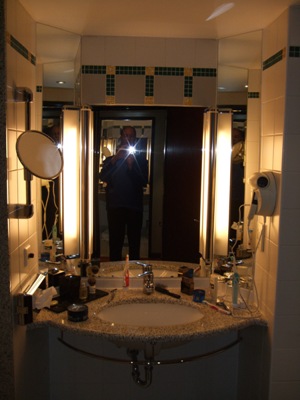 The bathroom too is like something out of a Busby Berkley musical.
The bathroom too is like something out of a Busby Berkley musical.
So, in our luxury hotel check, we have
However, we don't have
Nevertheless, I'm sure we'll survive.
We settled and then strolled. Roland had explained to me how big Vienna was and how it would take hours to walk between places. Even pushing a wheelchair, the four of us managed to make very good time. Hotel to Stephansdom, the main cathedral, took us about forty minutes and that was with a lot of stopping and looking. We ate Italian and then back to bed.
It was an uncomfortable night as the air conditioning was pretty ineffective. We mentioned this at reception and were told initially that Viennese air conditioning is not as stern as American air conditioning. We replied that the air conditioning in Ross's parents' room was much more effective. We were told that someone would look at it for us.
So, we set off on another adventure with the quest to discover a whole new city. By this stage in the holiday, I'd lost all notion of days of the week. I was somewhat startled to realise that it was a Monday and so the busy pavements were thronged with local residents going about their business or travelling to work at the beginning of a new week.
Our hotel is very near the Belvedere, which was the summer residence of Prince Eugene of Savoy, saviour of Vienna against the Turks in 1683.
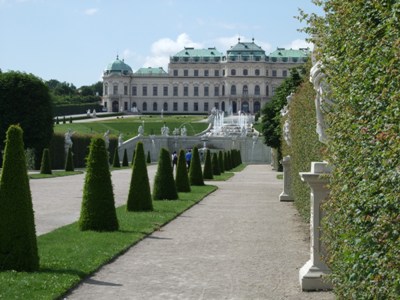
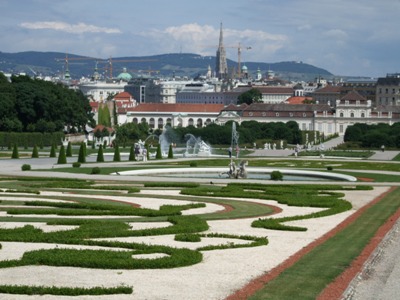
 The palace is situated on top of one of the few hills in the centre of Vienna (which despite being on a river is a very flat city - praise the Lord after Brussels and Nuremberg). The formal gardens have been recently done up and are a delight. However, pushing a wheelchair up the slope (gentle though it was) was a chore in the increasing heat.
The palace is situated on top of one of the few hills in the centre of Vienna (which despite being on a river is a very flat city - praise the Lord after Brussels and Nuremberg). The formal gardens have been recently done up and are a delight. However, pushing a wheelchair up the slope (gentle though it was) was a chore in the increasing heat.
Nevertheless, we were here for the art not the building.
We took in a fair proportion of the permanent collection although we missed out on the Baroque and Classical sections - just not interested I'm afraid. I did spend a while with the Romantic collection from Vienna's Biedermeier era and there were a couple of very pleasant Caspar David Friedrichs there. The Impressionist selection as good fun. I like the Corots and the Pissaro; there was a pleasant portrait of a chef by Monet (at last a pleasing work from Monet that wasn't waterlilies). But there was nothing really that London couldn't offer me.
That really didn't matter, however. Because the reason that anyone goes to the Upper Belvedere is to see the Klimts and, after the exhibition at Tate Liverpool two years ago, I was eager to see more.
The most iconic painting of them all is, of course, The Kiss. Coming to Vienna and not taking the opportunity to see this work is like going to Paris and avoiding The Mona Lisa in the Louvre.

There were the usual group of portraits of society women, including the original of Adele Bloch-Bauer as seen above our bed at the hotel, as well as other luscious images of womanhood.


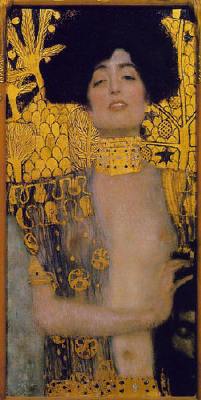
However, it was, as with the Liverpool exhibition, the scenes of nature which held my attention most.


There were also a number of works by Egon Schiele which caught my eye.

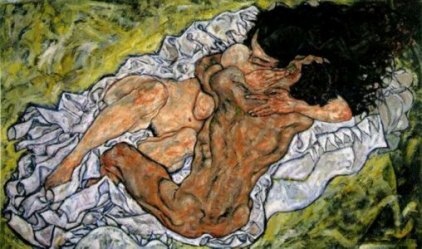
 And there was also one moment of complete shock and that was when I came across this painting. It is by Giovanni Segantini; it is called Evil Mothers and there is one very like it in the Walker Art Gallery in Liverpool. I must investigate on my return.
And there was also one moment of complete shock and that was when I came across this painting. It is by Giovanni Segantini; it is called Evil Mothers and there is one very like it in the Walker Art Gallery in Liverpool. I must investigate on my return.
So, viewing art in Vienna got off to an very good start.
![]()
We trotted off into Vienna. Lunch was some sandwiches, fruit and juice ate in the open air. And then we began to follow some of the walks in our Dorling Kindersley book.
We went past the Karlsplatz and the Karlskirche, where Anton Bruckner played the organ and Gustav Mahler was married. A little further on we came upon the Secession Building - this houses the reconstituted Beethoven frieze which was replicated in Liverpool's Gustav Klimt exhibition. Roland had told us that it would take more than an hour to get from the Upper Belvedere to here. Allowing for lunch, I think that thirty minutes would be nearer the mark.


More or less over the road, we came to Vienna's grand Opera House. Maybe some day I shall get to see inside. Behind that was the Hotel Sacher where in 1840 the world famous Sachertorte was first created.

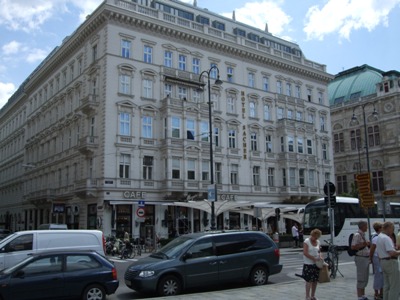
 We headed down to the cathedral area but did not spend a lot of time in the Stephansdom. Frankly, it didn't look that interesting despite its nice green and yellow tiled roof. We hung a left down Graben and came up to the Pestsaüle, one of Vienna's many monuments to plague and/or disaster.
We headed down to the cathedral area but did not spend a lot of time in the Stephansdom. Frankly, it didn't look that interesting despite its nice green and yellow tiled roof. We hung a left down Graben and came up to the Pestsaüle, one of Vienna's many monuments to plague and/or disaster.
From here our guided tour took us off into the back streets of old Vienna in which we encountered any number of well preserved houses in the style of the eighteenth century. I say in the style of as you can never be quite sure as to what is original and what is a replacement after he bombing of 1945. The opera house, for example, is a complete re-build.
We also found the Mozart house on Domgasse where he composed Le nozze di Figaro. It's difficult to move around Vienna without tripping over musical connections. I didn't go in. Maybe another time.
 The walking tour also pointed out churches of note. In Vienna, this mostly means an encounter with the Baroque.
The walking tour also pointed out churches of note. In Vienna, this mostly means an encounter with the Baroque.
This is not my favourite style. I suppose, as a Quaker, I am more than used to the plain and simple. These two words do not feature in the Baroque vocabulary.
If you take this, the Jesuitenkirche, for example, the architect Andrea Pozzo seems to have referenced every single type of marble that he could lay his hands on.
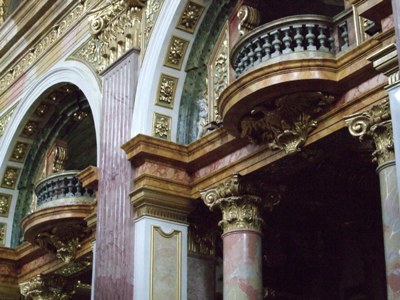
A little further on we had a look into the Dominikanerkirche. Although this appears to be more chaste with the white walls and ceiling, in fact every surface which does not have a painting on is embellished with some some of plaster scroll or curlicue.
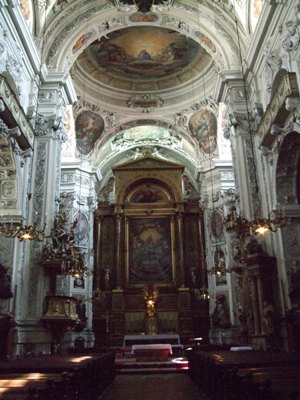
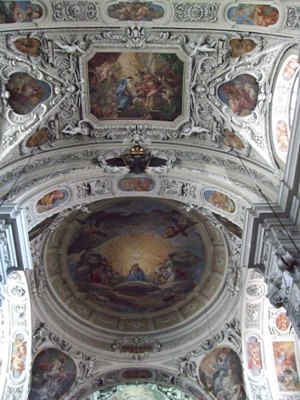
By this point, we had had enough. Or perhaps a better way of expressing it would be to say that we were reaching overload. I trundled Ross back to the hotel along Kartnerstrasse and then round the Ring.
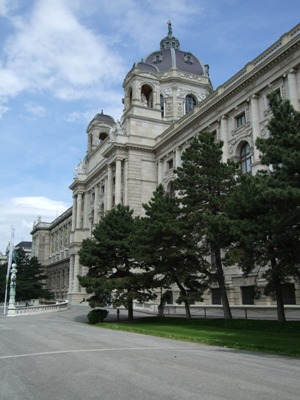 Once Ross was bedded I down, I headed off to the Kunsthistorisches Museum. We'd agreed in advance that he didn't want to visit this space and so I was quite content to go on my own. However, disaster struck. Well, not disaster but our plans got thrown out of kilter. It was a Monday. We'd completely failed to pick up on the fact that the building was shut on a Monday.
Once Ross was bedded I down, I headed off to the Kunsthistorisches Museum. We'd agreed in advance that he didn't want to visit this space and so I was quite content to go on my own. However, disaster struck. Well, not disaster but our plans got thrown out of kilter. It was a Monday. We'd completely failed to pick up on the fact that the building was shut on a Monday.
I thought "Oh, phooey!" and wondered what to do instead.
On a whim, I decided to go to the Leopold Museum which Ross and I had planned to visit on the following day to see what the wheelchair access was like. It was open. However, it was going to be closed on Tuesday.
The dilemma was momentary. I couldn't magic the Museum open for Ross on the following day. If I didn't go in now, I'd miss out as well. No brainer. I went in.
 The Leopold Museum sells itself on having the largest collection of works by Egon Schiele in the world. And there are a lot of them in the gallery. I was tremendously taken by the control of colour and by the draftsmanship of the works. However, and I'm saying nothing new here, there is something rotten about his view of the world. It's not just sordid, it's tainted in some way. I absolutely get the feeling that I would to have liked to have spent time in this man's company.
The Leopold Museum sells itself on having the largest collection of works by Egon Schiele in the world. And there are a lot of them in the gallery. I was tremendously taken by the control of colour and by the draftsmanship of the works. However, and I'm saying nothing new here, there is something rotten about his view of the world. It's not just sordid, it's tainted in some way. I absolutely get the feeling that I would to have liked to have spent time in this man's company.


 The Gallery also sells itself on the name of Gustav Klimt but I found this aspect of the collection really disappointing. There's one major work, the Death and Life opposite. After that, there's some sketches, some not very impressive landscapes and that's about it. I was underwhelmed.
The Gallery also sells itself on the name of Gustav Klimt but I found this aspect of the collection really disappointing. There's one major work, the Death and Life opposite. After that, there's some sketches, some not very impressive landscapes and that's about it. I was underwhelmed.
One artist whose name I had never heard of before but who struck me as being quite wonderful was Richard Gerstl. There were two self-portraits among the paintings on display. The first, on the left, was executed when he was just twenty-one. It might be a little buttoned up but I think that it is quite mesmeric. The second, much more fluid in its technique, was committed to canvas just four years later. They are quite different but, I think, quite astonishingly good.
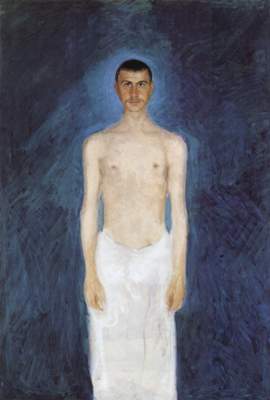
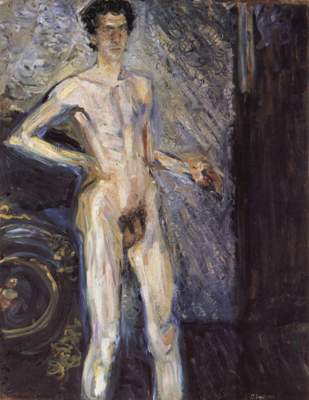
So, I wondered why I hadn't heard of the name before.
Well, it turns out that the second portrait was the last work which he completed before he committed suicide by hanging himself in his studio. He'd had a passionate affair with the composer Arnold Schoenberg's wife Mathilde and it had all gone horribly wrong. Not only did he lose a love but he also lost the company of the Schoenberg family and he was shunned by friends and Vienna society. A stronger character might have toughed it out. Richard Gerstl didn't. It's a grubby little story on the sidelines of the artistic history of Vienna in the early twentieth century.
 There were also paintings by Koloman Moser which caught the eye although his most important contribution to the arts and crafts of the era was his work (and Otto Wagner's) for the Wiener Werkstätte, a movement which drew inspiration from William Morris and the English Arts and Crafts movement of the later nineteenth century and had links back to Charles Rennie Mackintosh and the Omega Workshops of the Bloomsbury Group. The more I see of this sort of work, the more I feel it as being a pan-continental shift of ideas.
There were also paintings by Koloman Moser which caught the eye although his most important contribution to the arts and crafts of the era was his work (and Otto Wagner's) for the Wiener Werkstätte, a movement which drew inspiration from William Morris and the English Arts and Crafts movement of the later nineteenth century and had links back to Charles Rennie Mackintosh and the Omega Workshops of the Bloomsbury Group. The more I see of this sort of work, the more I feel it as being a pan-continental shift of ideas.
One of the gallery's information notices brought me up short. Egon Schiele died in 1918. Gustav Klimt died in 1918. Koloman Moser died in 1918. Otto Wagner died in 1918. Not only did a political order come to and end in that year but a whole school of artistic thought and endeavour ceased as well. The gallery certainly gave a broad coverage to that period and was a very good experience.
![]()
I relaxed in the gallery bar with a beer and a book before returning to the hotel and then we were out for another meal.
 Ross's dad was keen to try the Naschmarkt up past the Opera House and Secession Building. The market has been in existence since the sixteenth century but this development happened when the River Wien was covered over. The overall concept was put through by Otto Wagner. The original cast iron units were designed by Johann Theodor Jaeger, who is best known as the designer of the Strudlhof steps (one landmark which is just too far for us to get to). The units were renovated back in the 1990s as the area was rejunvenated. (I'm getting all this from the guidebook by the way)
Ross's dad was keen to try the Naschmarkt up past the Opera House and Secession Building. The market has been in existence since the sixteenth century but this development happened when the River Wien was covered over. The overall concept was put through by Otto Wagner. The original cast iron units were designed by Johann Theodor Jaeger, who is best known as the designer of the Strudlhof steps (one landmark which is just too far for us to get to). The units were renovated back in the 1990s as the area was rejunvenated. (I'm getting all this from the guidebook by the way)
The market itself is a foodie's paradise with fresh fruit, vegetables and fish on sale during the day and then bistro after bistro open for food at night.
We ate out in the open and had probably the best meal of the holiday so far. Ross and his mum had schnizel, I had a loin of pork and Ross's dad had ribs - actually its looked as though he had half a cow - the fact that he finished it off was an act of pure heroism.
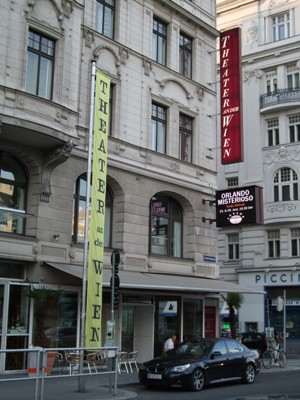 Looking in the guidebook, I discovered that, close by where we were eating, was the apartment in which Franz Schubert breathed his last. There's a memorial museum there and maybe, some day, I shall visit but, on this trip at least, there simply isn't the time.
Looking in the guidebook, I discovered that, close by where we were eating, was the apartment in which Franz Schubert breathed his last. There's a memorial museum there and maybe, some day, I shall visit but, on this trip at least, there simply isn't the time.
A little further down from where we were eating, I got really excited by this building, the Theater an der Wien.
Just an ordinary theatre?
Yes but it was the venue for the first ever performance of Beethoven's Fidelio and its first impresario was Emanuel Schikaneder who wrote the libretto for Mozart's Magic Flute as well as taking the part of Papageno for the first performances.
Classical music. Vienna is just that sort of city.
The guidebook also told us about the Wagner apartments with their Jengenstil design so we went to have a look. They are rather splendid. They were designed by Otto Wagner. A little further into town and we happened across the Karlsplatz Pavilions which were also designed by Otto Wagner.
Early twentieth century art and design. Vienna is just that sort of city too.

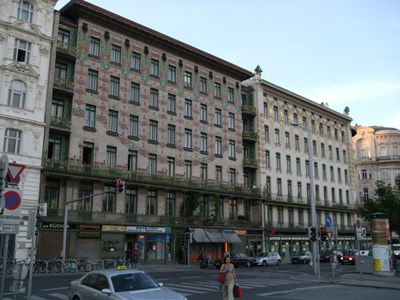

We slept well that night and I stocked up with a monster breakfast in the morning. Our air conditioning had been fixed as well.
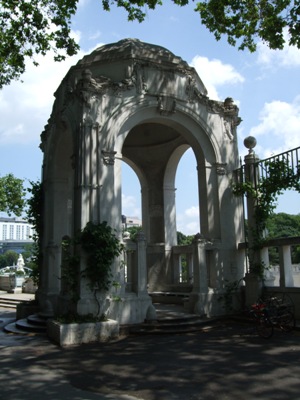 We decided to give the morning over to wandering using the Dorling Kindersley book as a guide. First off, we thought we would take a different route into town via the Stadtpark. The first thing that you see are these magnificent portals by Friedrich Ohmann.
We decided to give the morning over to wandering using the Dorling Kindersley book as a guide. First off, we thought we would take a different route into town via the Stadtpark. The first thing that you see are these magnificent portals by Friedrich Ohmann.
The river that you can see in the photograph below is the River Wien. This is the same river as in the Theater an der Wien and which was covered over to create the area for the Naschmarkt.
Somehow, all of this reminds me of scenes from Los Angeles which I have seen in movies. The storm drains there are reminiscent of this design. I guess, come the Anschluss, architectural talent fled alongside artistic talent.
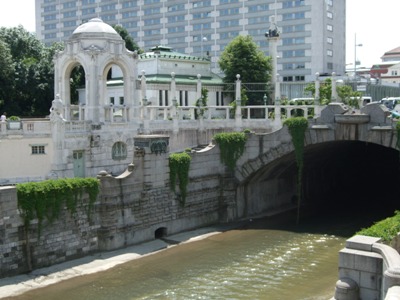
In the park itself, we came across a number of statues. Below are three commemorating composers. There were others recognising politicians as you might expect. But there were also some celebrating scientists, medical people, architects, engineers. And it was like this throughout the city. We tend only to celebrate royalty, the military and politicians. Maybe, in the UK, we should spread our wings and, like the Viennese, make more of those heroes who expand the sum total of human knowledge and contribute to improving the way we live.



 Initially, we did not follow any of the official walks in our guidebook because we were heading for another piece of design by Otto Wagner, the Postsparkasse. Actually getting in with a wheelchair was a bit of a schlepp - round the back, through the security gate, down a corridor, up in a life, right, left and back again. When we left, we came out the front entrance and Ross eased himself down the steps whilst I bumped the wheelchair down on my own.
Initially, we did not follow any of the official walks in our guidebook because we were heading for another piece of design by Otto Wagner, the Postsparkasse. Actually getting in with a wheelchair was a bit of a schlepp - round the back, through the security gate, down a corridor, up in a life, right, left and back again. When we left, we came out the front entrance and Ross eased himself down the steps whilst I bumped the wheelchair down on my own.
The room itself was light and airy with the supporting metal columns clad in aluminium and the heating supplied through tubular metal columns (you can pick them out either side of the doors).
 From there we headed off towards the Stephansdom again but this time towards the Hohermarkt and the Jewish district. We stopped off to look at Anker clock, designed for the Anker Insurance Company by Franz Matsch (Insurance companies seem to have contributed a lot in terms of architecture and design - is that a measure of their power, wealth, greed or what?)
From there we headed off towards the Stephansdom again but this time towards the Hohermarkt and the Jewish district. We stopped off to look at Anker clock, designed for the Anker Insurance Company by Franz Matsch (Insurance companies seem to have contributed a lot in terms of architecture and design - is that a measure of their power, wealth, greed or what?)
On the hour, cut-outs of historical figures process across its face. the most spectacular display is at 12 noon. We decided that we did not want to be thronged by the press of other tourists and kept going.
Just round the corner we found ourselves in Judenplatz. I cannot imagine anywhere in the UK which would name a square for the Jewish race. It's not part of the British psyche to do such a thing.
In the square is Rachel Whiteread's Holocaust Memorial. This is labelled as being "controversial". I'm not quite sure why. Rachel Whiteread is famous for taking casts of rooms and buildings and turning them inside out and that's what you have here. It's certainly not grand or bombastic. And I suppose that that was her starting point. How do you create a monument to the millions who were butchered? We don't really live in an age where something like the Pestsaüle could be contemplated.
 Here's my take on what it tries to do.
Here's my take on what it tries to do.
The true memorial to the Holocaust is the names of those who died. This inverted room is a library. The walls are lined with books. The books contain the names. The room is inverted but then so was history and morality at that period. The doors have no keyholes. Once you are in, it is impossible to get out. For many, that was true of the camps. For us, we cannot get in. We weren't there and so we have no idea of what it was like.
Only the names stand witness and testimony.
A short while later, we stopped for lunch at a vegetarian café and ate out on the terrace. Fortified, we pressed on into the heat of the day.
And at this point, I need to make a small criticism of our Dorling Kindersley books. They are, in most respects, an excellent tool for the sort of sight-seeing which we wish to do. In order to guide you round a large city, they adopt the strategy of breaking the place into different quarters or zones.
With Brussels, this worked well because the escarpment marked a break between the medieval Flemish area and the imperial nineteenth century area. With Vienna, it's less clear that the zones are entirely logical.
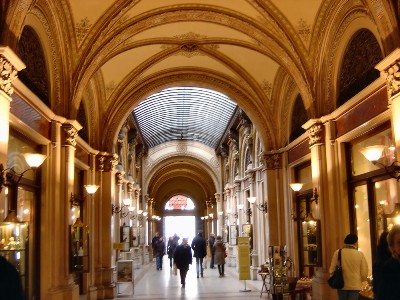 And, had we kept to the zones, we would have missed out on the Freyung Passage, a covered shopping arcade like the Galleries St Hubert in Brussels.
And, had we kept to the zones, we would have missed out on the Freyung Passage, a covered shopping arcade like the Galleries St Hubert in Brussels.
However, where Galleries St Hubert was all light and glass and white walls, the Freyung Passage is all gleaming, cosy wood.
In Germanic terms, it is gemütlich.
 Round the corner, we were back on track with a Dorling Kindersley walk through Imperial Vienna in the Hofburg Quarter. Here were the houses of the nobility and, on Kohlmarkt, an apartment once used by Josef Haydn - those classical music references just keep piling up.
Round the corner, we were back on track with a Dorling Kindersley walk through Imperial Vienna in the Hofburg Quarter. Here were the houses of the nobility and, on Kohlmarkt, an apartment once used by Josef Haydn - those classical music references just keep piling up.
On the Michaelerplatz, we stopped to look at the Loos House, another example of Jungendstil design. This one completely offended Crown Prince Franz Ferdinand - the one that stopped a bullet in Sarajevo thus contributing to the sequence of events that led to both my grandfathers stopping bullets of their own on Flanders' fields.
Maybe, by this time I was becoming more blasé about the whole design thing but I couldn't see what all the fuss was about.
 I felt that I'd done Baroque churches on the previous day with the Jesuitenkirche and the Dominikanerkirche. But by this time it was so hot that I just needed to get out of the shade into somewhere cool. So, I nipped in to the Michaelerkirche.
I felt that I'd done Baroque churches on the previous day with the Jesuitenkirche and the Dominikanerkirche. But by this time it was so hot that I just needed to get out of the shade into somewhere cool. So, I nipped in to the Michaelerkirche.
And if I hadn't done that I would have missed out on one of the biggest laughs that I had all holiday.
The centrepiece of the Michaelerkirche is an altarpiece by Karl Georg Merville replete, as the guidebook has it, "with tumbling angels and sunbursts.
Frankly, darlings, it is as camp as Christmas.
By this stage, Ross was flagging so we went back to the hotel so that he could nap and I then pressed back into the fray for my delayed visit to the Kunsthistorisches Museum.
 First thing to say is that this is an Imperial gesture which was built in the 1870s and 1880s alongside a a Natural History Museum of equally grand proportions. Presumably, this was a response to London's Albertopolis (1850s-1880s) with its Victoria and Albert Museum, Royal Albert Hall, Natural History Museum, Imperial College, etc all in South Kensington.
First thing to say is that this is an Imperial gesture which was built in the 1870s and 1880s alongside a a Natural History Museum of equally grand proportions. Presumably, this was a response to London's Albertopolis (1850s-1880s) with its Victoria and Albert Museum, Royal Albert Hall, Natural History Museum, Imperial College, etc all in South Kensington.
Frankly, with a grand staircase of that nature, you know exactly what sort of milieu you are entering.
I should say straight off that I was disappointed with the collection. Unfairly, probably, I kept thinking that it was all much less exciting than London's National Gallery for the French and Italian works of art and much less impressive than the Prado for the Spanish and Flemish/Dutch works.
Vienna has half a dozen or so very good works by Velázquez; the Prado has six rooms' worth. Vienna has a few very good works by El Greco; the Prado has a whole room's worth. Vienna has a few very good works by Rubens the Prado has three or four rooms' worth. And so on.
Maybe, however, I was simply falling victim to culture fatigue.
Things picked up in the early German galleries. There were a number of excellent works by Dürer and Cranach for me to enjoy. The Cranach work of Judith with Holofernes's Head was a great contrast to the one by Klimt in the Belvedere.


And then I found the room with all the Bruegels and time stood still.
They are just stupendous.
I spent probably about ninety minutes looking at the collection as a whole. Probably a third of that time was spent just in that one room. What can you say? Like the old News of the World strap line, all human life is there. I was in awe.




So, for the majority of the collection, I would say that a good three stars matches my (perhaps jaundiced) response. ![]() The Dürers and the Cranachs, however, were very good.
The Dürers and the Cranachs, however, were very good. ![]() The Bruegels were excellent.
The Bruegels were excellent. ![]()
So, we got to our final evening in Vienna and ate out at the Café Gutenberg on the terrace yet again. My goodness, we have been lucky with the weather.
I opted for my first taste of Wiener Schnitzel and so I went the traditional veal route. To be honest, I'm not sure that I was that impressed. Mine was a bit salty. Ross had a pork variant and that was more pleasant. I had Sachertorte mit Schlagobers to complete an echt Viennese culinary experience and, though the dark bitter chocolate of the cake was fine, I rather think that the whipped cream was sprayed from a can.
And that was it for Vienna. A night's sleep and next stop Budapest.